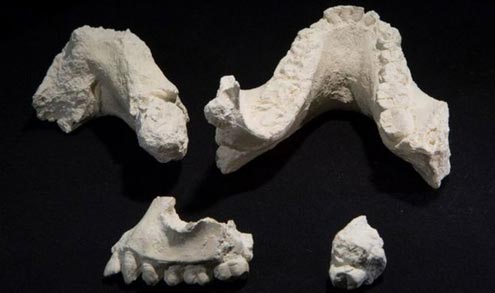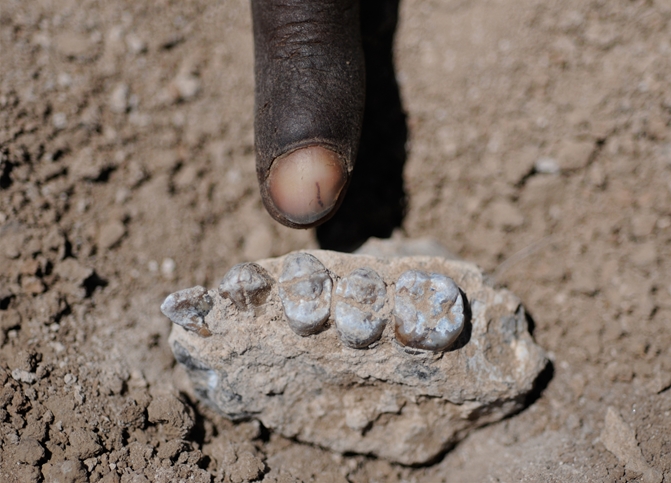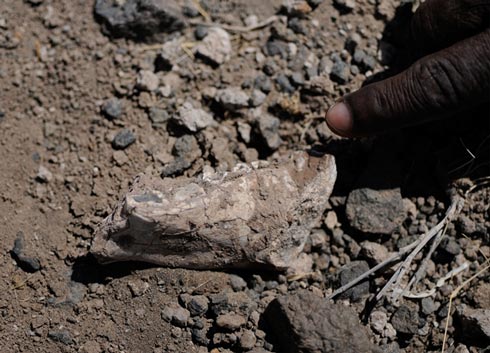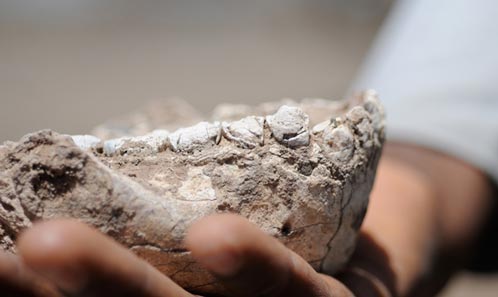A New Face to the Human Family Tree
Australopithecus afarensis Had Neighbours! Say Hello to Australopithecus deyiremeda
Had you and I been able to travel back in time to the Afar region of northern Ethiopia some 3.4 million years ago in a bid to meet our ancient ancestors, we might have been spoilt for choice when it comes to trying to work out from which species we are descended from. Lucy* the most famous example of Australopithecus afarensis had company, she had neighbours, a newly described species of Australopithecine has just been announced.
Two fragmentary upper jaws along with two fragments of lower jaws, representing fossil material from three individuals were found in March 2011 in the Woranso-Mille area of the Afar region. These fossils have been assigned to an entirely new genus of Australopithecine, say hello to Australopithecus deyiremeda.
Casts of the Four Fossil Jaws are Displayed
Picture credit: Laura Dempsey
Australopithecus deyiremeda
The fossil material assigned to Australopithecus deyiremeda (pronounced ost-tral-oh-pith-e-kus day-ihremy-dah) was described by a team of international palaeoanthropologists led by Dr Yohannes Haile-Selassie, the Curator of Physical Anthropology at the Cleveland Museum of Natural History (Cleveland, Ohio). The fossils are estimated to between 3.3 million and 3.5 million years old, which means that this species overlapped and lived in the same region as Australopithecus afarensis, the species that the famous fossils called “Lucy” have been assigned to.
However, although A. deyiremeda and A. afarensis lived at the same time and shared the same habitat, the “Lucy” fossil material has been dated to 3.2 million years ago, meaning that the most famous representative of the Australopithecus afarensis species – “Lucy” lived more recently and could never have met the individuals whose jawbones have been preserved.
A Field Photograph Showing the First Jaw Fragment Found
Picture credit: Yohannes Haile-Selassie/Cleveland Museum of Natural History
The picture above shows a field photograph of the holotype (upper jaw), five teeth can be clearly seen.
A Significant Fossil Discovery
The discovery of this new species is significant for a number of reasons.
- This is the first irrefutable evidence of two species of Australopithecine co-existing. These two species lived at the same time in the Middle Pliocene and in the same part of the world.
- These fossils suggest that the Australopithecus genus was more diverse than previously thought, it had been thought that the Homo genus evolved from A. afarensis but this may not have been the case, a number of candidate species are emerging.
- The morphology of the jaws, the size and shape of the teeth and their enamel thickness suggest characteristics not found in A. afarensis but more akin to later genera, the Paranthropus and the Homo genus, for example. These traits go back much further in time than previously thought.
The Left Half of a Lower Jaw Found on March 4th 2011
Picture credit: Yohannes Haile-Selassie/Cleveland Museum of Natural History
Published in the Journal “Nature”
The academic paper that details this discovery has just been published in the journal “Nature”. In recent years, the hypothesis of a relatively simple, linear progression from Australopithecus to the Homo genus and ultimately the origin of our own species has become less popular amongst researchers. It seems the hominin family tree is much more complicated than previously thought.
To read an article written by Everything Dinosaur back in 2011, about other Australopithecus discoveries, but this time from southern Africa: The Human Family Tree Just Got More Complicated.
A Close Up of the Left Lower Jaw Prior to Cleaning
Picture credit: Yohannes Haile-Selassie/Cleveland Museum of Natural History
A. afarensis Not the Only Potential Human Ancestor
Commenting on the importance of this fossil discovery Dr Yohannes Haile-Selassie stated:
“The new species is yet another confirmation that Lucy’s species, Australopithecus afarensis, was not the only potential human ancestor species that roamed in what is now the Afar region of Ethiopia during the Middle Pliocene. Current fossil evidence from the Woranso-Mille study area clearly shows that there were at least two, if not three, early human species living at the same time and in close geographic proximity.”
Dr Yohannes Haile-Selassie added:
“This new species from Ethiopia takes the ongoing debate on early hominin diversity to another level. Some of our colleagues are going to be sceptical about this new species, which is not unusual. However, I think it is time that we look into the earlier phases of our evolution with an open mind and carefully examine the currently available fossil evidence rather than immediately dismissing the fossils that do not fit our long-held hypotheses”.
The Very Near Complete Lower Jaw (Field Photograph)
Picture credit: Yohannes Haile-Selassie/Cleveland Museum of Natural History
Early Hominins Co-existing
This discovery raises the question of how multiple types of early hominins may have been able to co-exist in the same environment. For those readers unfamiliar with the term hominin, a hominin is defined as a species more closely related to humans than to our closest extant ape relative the chimpanzee. Clues can be found in the fossilised jaws and teeth. The jaws of A. deyiremeda are very deep and robust, but the teeth are proportionately smaller than seen in other Australopithecines.
The canine teeth are particularly small, smaller than all known hominins that have been described previously. The jaws and teeth may reflect adaptations to a different type of diet.
A member of the Everything Dinosaur team explained:
“Teeth are relatively common in the hominin fossil record, as the extreme hardness of the enamel means that, compared to bones for example, they have a greater fossilisation potential. If patterns of wear can be discerned then it might be possible to hypothesis on the diet of this new species. As the jaws and teeth are different from A. afarensis, it could be assumed that these two hominins did not compete directly with each other for food resources, in short, each species ate different types of food.”
Significant Canine Teeth
The size of the canine teeth may also be very significant. We have four canine teeth, two in the top jaw and two in the lower jaw. They sit between the first premolar and the last incisor and the size of the canine teeth can provide evidence about social behaviours associated with a species.
In primates, where males compete with each other over females, the canine teeth of the males are usually much larger than the canines of females. Canine teeth can be used as weapons as the males fight each other to establish social hierarchies and dominance.
A Close Up of the Upper Jaw Fragment with the Canine Tooth Highlighted
Picture credit: Laura Dempsey, with additional annotation by Everything Dinosaur
If more teeth ascribed to A. deyiremeda can be found, then more research can be undertaken on the potential dietary differences between different hominins and some exciting inferences about social behaviours and social structures could be made.
Everything Dinosaur, acknowledges the contribution of the Cleveland Museum of Natural History in the compilation of this article.
For models and replicas of early hominins and other prehistoric creatures: Wild Safari Prehistoric World Figures and Replicas.







